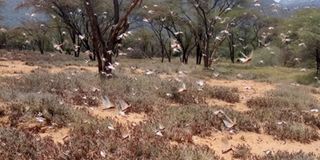Breaking: Autopsy reveals how Cyrus Jirongo died
Premium
Samburu stares at second wave of desert locust invasion

Desert locusts in Legarde, Samburu East on August 19, 2020.
What you need to know:
- The incursion seems to have started earlier than experts had predicted.
- The arrival of the pests has sparked anxiety over food security in the region yet to recover from the first wave of invasion by the insects late last year.
Disaster response teams in Samburu have warned of a second wave of locust invasion after seven swarms were spotted in the county yesterday.
The incursion seems to have started earlier than experts had predicted.
In its latest report, the Food and Agriculture Organisation (FAO) of the United Nations had predicted that new swarms would land in northern Kenya in mid-November as a result of new breeding in Ethiopia and Somalia.
The arrival of the pests has sparked anxiety over food security in the region yet to recover from the first wave of invasion by the insects late last year.
Experts say the locusts, which were directed to the country by cyclones and a quest for unseasonably wet weather, were first spotted in Wajir and Mandera.
Earlier this year, Agriculture Cabinet Secretary Peter Munya said the government would contain the invasion by September and declare Kenya locust-free.
Increased rainfall
Experts say increased rainfall in the Horn of Africa, coupled with warmer weather, is creating ideal breeding conditions for locusts.
FAO’s October 19 report says more swarms are breeding in Ethiopia, with a new generation of hatching in central Somalia.
Samburu County Special Programmes Chief Officer Daniel Lesaigor told the Nation they were keeping tabs on the swarms’ migratory paths to determine whether the pests are part of a new invasion or survivors from the third generation.





